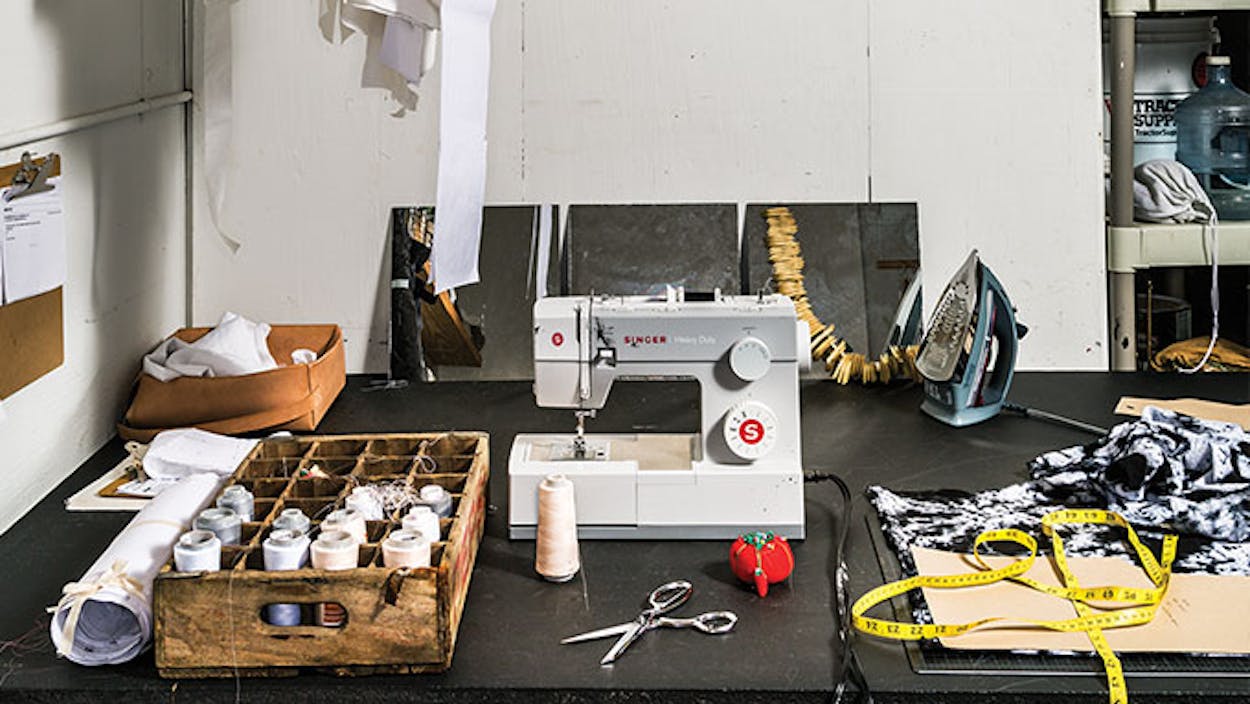In the sprawling backyard of the Houston Foundry, an industrial site turned artists’ studio just north of downtown, 29-year-old Kate dePara looks a bit like a mad scientist. Crouched over twenty yards of fabric spread across the ground, her hands sheathed in sturdy rubber gloves, she applies dye with an assortment of tools—spray bottles, sponges, a bamboo paintbrush, a fork. Nearby, another length of fabric sits in a bucket of steaming-hot water, while others dry on a giant wooden rack. Eventually, these fabrics will be transformed into the garments and accessories that make up Evens, the minimalist clothing line dePara launched in 2012.
In addition to hand-dyeing her material, the Nassau Bay native also designs her own prints, and she chose the name Evens to reflect a balance between natural and digital processes. Regarding her decision to leave her fashion-industry job in New York and study fibers at the Savannah College of Art and Design prior to starting her own company, dePara says, “My job was more on the sales side, and I found myself being drawn to what the designers were up to. But it was also just growing up. Over time, you realize you can do anything you want—you are the only person in charge of your future.”
Q&A with Kate DePara
How did you decide to pursue textile design?
During my last semester as an undergraduate at Baylor, a professor saw me drawing a lot of repetitive motions and suggested I look into textile design, so it all started there. It is such a quiet field and is often overlooked as a profession.
Why do you think that is?
Designers throughout history have treated the creation of the textile and the construction of the garment as though they are interchangeable. They aren’t often broken down into two different things, but I think they are very different.
Obviously you love textile design. Do you also enjoy garment design and construction?
I don’t spend that much time sketching designs or silhouettes of the clothes. When it comes to designing the actual garments, I go straight to the fabrics and start cutting, which is what everyone tells you not to do. But it’s the only way I know how to do it.
What kinds of fabrics do you use?
I always work with natural materials, like cotton, flax, and silk. You can manipulate them in really humble ways. I love looking at the flax plant that is growing in my front yard and knowing it can be made into a dress.
Where do your inspirations for textile patterns come from?
My inspiration always seems to come from the earth. I take a plain, ordinary object or mark that standing alone feels obvious and trite, but once you multiply it and cover a surface with it, it takes on a life of its own. It’s a surprise to see what happens when you rotate and duplicate individual objects. And growing up in Texas around a minimal landscape definitely influenced my work and color palette. I am a sucker for simple lines, rocky textures, blond fields, still water, and neutral tones.
What is something specific in nature that has inspired you lately?
For my fall collection, I have been working with sheets of mica, magnifying scans and developing them into a pattern. Mica is so naturally beautiful and has a shape that is conducive to the process of rendering a textile design. I mostly like the edges and line quality and the vast array of colors you can find when you look closely.
What’s it like for you working in Houston?
It’s a super-exciting time in the city. The vibe is becoming younger, and people are staying and helping to build a new arts community. In the past, Houston has been so focused on high art and prestigious galleries, but things are shifting. The community of makers helps each other, whether it’s through sharing resources or helping to make each other visible.
For more information, go to shopevens.com.
- More About:
- Style & Design
- Fashion








